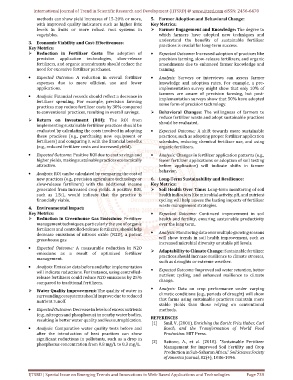Page 748 - Emerging Trends and Innovations in Web-Based Applications and Technologies
P. 748
International Journal of Trend in Scientific Research and Development (IJTSRD) @ www.ijtsrd.com eISSN: 2456-6470
methods can show yield increases of 15-20% or more, 5. Farmer Adoption and Behavioral Change:
with improved quality indicators such as higher Brix Key Metrics:
levels in fruits or more robust root systems in Farmer Engagement and Knowledge: The degree to
vegetables. which farmers have adopted new techniques and
3. Economic Viability and Cost-Effectiveness: understand the benefits of sustainable fertilizer
Key Metrics: practices is crucial for long-term success.
Reduction in Fertilizer Costs: The adoption of · Expected Outcome: Increased adoption of practices like
precision application technologies, slow-release precision farming, slow-release fertilizers, and organic
fertilizers, and organic amendments should reduce the amendments due to enhanced farmer knowledge and
need for excessive fertilizer purchases. training.
· Expected Outcome: A reduction in overall fertilizer · Analysis: Surveys or interviews can assess farmer
expenses due to more efficient use and fewer knowledge and adoption rates. For example, a pre-
applications. implementation survey might show that only 10% of
· Analysis: Financial records should reflect a decrease in farmers are aware of precision farming, but post-
fertilizer spending. For example, precision farming implementation surveys show that 50% have adopted
some form of precision technology.
practices may reduce fertilizer costs by 30% compared
to conventional practices, resulting in overall savings. Behavioral Changes: The willingness of farmers to
reduce fertilizer waste and adopt sustainable practices
Return on Investment (ROI): The ROI from
should be evaluated.
implementing sustainable fertilizer practices should be
evaluated by calculating the costs involved in adopting · Expected Outcome: A shift towards more sustainable
these practices (e.g., purchasing new equipment or practices, such as adopting proper fertilizer application
fertilizers) and comparing it with the financial benefits schedules, reducing chemical fertilizer use, and using
(e.g., reduced fertilizer costs and increased yield). organic fertilizers.
· Expected Outcome: Positive ROI due to cost savings and · Analysis: Changes in fertilizer application patterns (e.g.,
higher yields, making sustainable practices economically fewer fertilizer applications or adoption of soil testing
attractive. before application) will indicate shifts in farmer
· Analysis: ROI can be calculated by comparing the cost of behavior.
new practices (e.g., precision agriculture technology or 6. Long-Term Sustainability and Resilience:
slow-release fertilizers) with the additional income Key Metrics:
generated from increased crop yields. A positive ROI, Soil Health Over Time: Long-term monitoring of soil
such as 1.5:1, would indicate that the practice is health indicators like microbial activity, pH, and nutrient
financially viable. cycling will help assess the lasting impacts of fertilizer
4. Environmental Impact: waste management strategies.
Key Metrics: · Expected Outcome: Continued improvement in soil
Reduction in Greenhouse Gas Emissions: Fertilizer health and fertility, ensuring sustainable productivity
management techniques, particularly the use of organic over the long term.
fertilizers and controlled-release fertilizers, should help ·
decrease emissions of nitrous oxide (N2O), a potent Analysis: Monitoring data over multiple growing seasons
greenhouse gas. will show trends in soil health improvement, such as
increased microbial diversity or stable pH levels.
· Expected Outcome: A measurable reduction in N2O
emissions as a result of optimized fertilizer Adaptability to Climate Change: Sustainable fertilizer
management. practices should increase resilience to climate stresses,
such as droughts or extreme weather.
· Analysis: Emission data before and after implementation ·
will indicate reductions. For instance, using controlled- Expected Outcome: Improved soil water retention, better
nutrient cycling, and enhanced resilience to climate
release fertilizers could reduce N2O emissions by 25%
change.
compared to traditional fertilizers.
· Analysis: Data on crop performance under varying
Water Quality Improvement: The quality of water in
surrounding ecosystems should improve due to reduced climatic conditions (e.g., periods of drought) will show
nutrient runoff. that farms using sustainable practices maintain more
stable yields than those relying on conventional
· Expected Outcome: Decrease in levels of excess nutrients methods.
(e.g., nitrogen and phosphorus) in nearby water bodies,
REFERENCES
resulting in better water quality and less eutrophication.
[1] Smil, V. (2001). Enriching the Earth: Fritz Haber, Carl
· Analysis: Comparative water quality tests before and Bosch, and the Transformation of World Food
after the introduction of best practices can show Production. MIT Press.
significant reductions in pollutants, such as a drop in [2]
phosphorus concentration from 0.8 mg/L to 0.3 mg/L. Bationo, A., et al. (2018). "Sustainable Fertilizer
Management for Improved Soil Fertility and Crop
Production in Sub-Saharan Africa." Soil Science Society
of America Journal, 82(4), 1086-1096.
IJTSRD | Special Issue on Emerging Trends and Innovations in Web-Based Applications and Technologies Page 738

